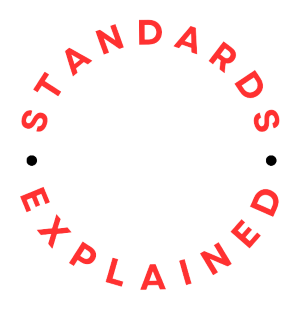ISO 14001:2015 Environmental management systems — Requirements with guidance for use is an international standard that provides guidelines and requirements for environmental management. It provides a framework for organizations to design, implement, and continually improve their environmental performance. The framework encompasses various aspects, from resource usage and waste management to monitoring environmental performance and involving stakeholders in environmental commitments.
By adhering to this standard, organizations can ensure they are taking proactive measures to minimize their environmental footprint, comply with relevant legal requirements, and achieve their environmental objectives.
Note that the standard was last reviewed and confirmed in 2021; therefore this version remains current.
What does it cover?
| Introduction |
| 1 Scope |
| 2 Normative references |
| 3 Terms and definitions |
| 3.1 Terms related to organization and leadership |
| 3.2 Terms related to planning |
| 3.3 Terms related to support and operation |
| 3.4 Terms related to performance evaluation and improvement |
| 4 Context of the organization |
| 4.1 Understanding the organization and its context |
| 4.2 Understanding the needs and expectations of interested parties |
| 4.3 Determining the scope of the environmental management system |
| 4.4 Environmental management system |
| 5 Leadership |
| 5.1 Leadership and commitment |
| 5.2 Environmental policy |
| 5.3 Organizational roles, responsibilities and authorities |
| 6 Planning |
| 6.1 Actions to address risks and opportunities |
| 6.2 Environmental objectives and planning to achieve them |
| 7 Support |
| 7.1 Resources |
| 7.2 Competence |
| 7.3 Awareness |
| 7.4 Communication |
| 7.5 Documented information |
| 8 Operation |
| 8.1 Operational planning and control |
| 8.2 Emergency preparedness and response |
| 9 Performance evaluation |
| 9.1 Monitoring, measurement, analysis and evaluation |
| 9.2 Internal audit |
| 9.3 Management review |
| 10 Improvement |
| 10.1 General |
| 10.2 Nonconformity and corrective action |
| 10.3 Continual improvement |
| Annex A Guidance on the use of this International Standard |
| A.1 General |
| A.2 Clarification of structure and terminology |
| A.3 Clarification of concepts |
| A.4 Context of the organization |
| A.5 Leadership |
| A.6 Planning |
| A.7 Support |
| A.8 Operation |
| A.9 Performance evaluation |
| A.10 Improvement |
| Annex B Correspondence between ISO 14001:2015 and ISO 14001:2004 |
Implementing ISO 14001
Implementing an Environmental Management System (EMS) in conformity with ISO 14001 involves establishing a structured approach to manage environmental impacts, reduce resource consumption, and improve sustainability within an organization.
Understanding the Organization’s Context
- Determine the internal and external issues that are relevant to the organization’s purpose and strategic objectives.
- Identify key stakeholders and other interested parties that are relevant to the EMS.
- Assess the need to interface the EMS with other management systems and the resources required for this purpose, if applicable.
Leadership and Commitment
- Obtain commitment from top management to implement and support the EMS.
- Appoint an Environmental Manager or Coordinator to lead the implementation efforts.
Scope Determination
- Determine the scope of your EMS, including the activities, locations, and processes that will be covered by ISO conformity with 14001.
Environmental Policy
- Develop an environmental policy that reflects your organization’s commitment to environmental protection and conformity with ISO 14001.
- Ensure the policy is communicated throughout the organization.
Legal and Regulatory Compliance
- Ensure that your organization is aware of and complies with all applicable environmental laws, regulations, and standards.
Environmental Aspects and Impacts Assessment
- Identify and assess the environmental aspects and impacts of your organization’s activities, products, and services.
- Determine the significance of each aspect and impact.
Setting Objectives and Targets
- Set specific, measurable, achievable, relevant, and time-bound (SMART) environmental objectives and targets.
- Ensure they align with your organization’s environmental policy and significant aspects.
Environmental Management Programs
- Develop plans and programs to achieve the established objectives and targets.
- Assign responsibilities and allocate resources for their implementation.
Operational Control and Procedures
- Establish procedures and work instructions to control activities with significant environmental aspects.
- Ensure employees are aware of and follow these procedures.
Emergency Preparedness and Response
- Develop and implement procedures for responding to environmental emergencies.
- Conduct drills and exercises to ensure preparedness.
Training and Awareness
- Provide environmental training to employees and contractors.
- Raise awareness about environmental issues and the organization’s objectives.
Communication and Stakeholder Engagement
- Establish effective communication channels with internal and external stakeholders regarding environmental matters.
- Engage stakeholders in environmental decision-making and reporting.
Performance Monitoring and Measurement
- Define Key Performance Indicators (KPIs) and metrics to assess the performance of your EMS.
- Implement monitoring and reporting systems.
Auditing and Review
- Conduct regular internal audits to assess the conformity and effectiveness of your EMS.
- Review the EMS periodically to ensure its continued suitability, adequacy, and effectiveness.
Management Review
- Hold periodic management reviews to evaluate the performance of the EMS and identify areas for improvement.
Continual Improvement
- Foster a culture of continual improvement by encouraging employees to suggest and implement enhancements to environmental practices.
- Use the Plan-Do-Check-Act (PDCA) cycle for continual improvement.
External Audit and Certification
- Engage with a certification body to perform an external audit to assess your EMS’s conformity with ISO 14001 standards.
Certification and Maintenance
- After successfully passing the certification audit, your organization will be granted ISO 14001 certification.
- Maintain and continually improve the EMS to ensure ongoing conformity.
Some further words of advice…
It is crucial to recognize that conformity with ISO 14001 is an ongoing process and so the organization should continually monitor and measure its environmental performance, adapt to changing environmental risks and regulations, and actively pursue environmental sustainability goals. Regularly review and update your EMS policies, objectives, and procedures to ensure they remain relevant and effective.
ISO 14001 can be purchased through the ISO.org website.














Comments (0)